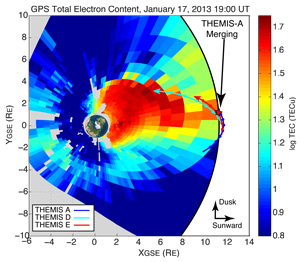
2014 THEMIS SCIENCE NUGGETS
Simultaneous Ground and Space-Based Observations of the Plasmaspheric Plume and Reconnection
by Brian M. Walsh
Space Sciences Laboratory, UC Berkeley
Introduction
Magnetic reconnection is the primary process through which energy couples from the solar wind into Earth’s magnetosphere and ionosphere. Whatever controls the efficiency of this process controls how energy is being transferred from the solar wind into the Earth’s plasma environment. The role of the solar wind flowing from outside the magnetosphere in controlling this energy transfer and driving our magnetosphere has been the focus of study for a number of years. Recent observations however expose how processes inside the magnetosphere provide critical feedback in lowering the efficiency of solar wind energy transfer.
| Figure 1. GPS TEC maps showing temporal evolution of the SED plume at noontime cusp. The plume persists for a number of hours and the black arrow indicates the position of the cusp signature in the TEC data. The gray circle in the top left panel is the magnetic footprint of THEMIS E as it crosses the reconnecting magnetopause at 18:22 UT. The black circle is the poleward precipitation boundary. |
Results
On January 17, 2013, a Coronal Mass Ejection (CME) propagating from the sun impacted the Earth’s magnetosphere resulting in a small geomagnetic storm, as indicated by the Disturbed Storm Time (Dst) index (minimum of -53 nT). During the storm, the ionospheric density increased and a long-duration Storm Enhanced Density (SED) plume developed in Total Electron Content (TEC) measurements (Fig. 1). The SED plume is a region of dense material extending from low latitudes in the dusk sector up towards the polar cap.
At the same time the ground based measurements showed an extended plume, three THEMIS spacecraft passed through the magnetopause in a string of pearls formation, one 45 minutes after the other. Each measured clear signatures of magnetic reconnection. Each spacecraft also measured large densities, several orders of magnitude larger than normal, indicating the presence of the plasmaspheric plume extending radially outward towards the sun. When mapped from the ionosphere to the magnetosphere along magnetic field lines (Fig 2), the TEC maps show the plume measured in the ionosphere aligns right where the THEMIS spacecraft measure their signatures of the plume in-situ. One important result of this work is that these conjugate measurements validate that the TEC maps can show the outward extension of the plume all the way to the reconnecting magnetopause.
| Figure 2. TEC measurements projected to the equatorial plane following magnetic field lines with the International Geomagnetic Reference Field (IGRF) model. The star indicates the position where the THEMIS A spacecraft crosses the magnetopause. Each filled circle along the orbit is one hour. The black line is a modeled position of the magnetopause |
A valuable result of this work is that the THEMIS measurements show evidence for the reconnection process being impacted by the dense plume material. The role of the dense material is identified in displacing the reconnection jet towards the magnetosheath and slowing the velocity of the jet through adding mass to the newly reconnected magnetic field lines. This demonstrates the dense plasmaspheric plume can impede the efficiency of reconnection at the magnetopause and the transfer of energy from the solar wind to the magnetosphere. Combined with the conjugate and simultaneous measurements of the plume from the ionosphere, the full circulation pattern and magnetospheric feedback system is shown.
Conclusion
The observations show the full circulation pattern of magnetospheric feedback and confirm the role of the plasmaspheric plume in slowing solar wind-magnetospheric coupling. When a strong solar wind structure contacts the magnetopause, it can deposit a large amount of energy. Efficient input of energy at the magnetopause initiates a geomagnetic storm, and plasmaspheric particles are transported sunward in a plume of plasma, sometimes reaching all the way to the magnetopause. Once the cold dense material in the plasmaspheric plume contacts the magnetopause boundary, it throttles the reconnection process and limits the transfer of energy, providing negative feedback to the system.
Reference
Walsh, B.M., J.C. Foster, P.J. Erickson, D.G. Sibeck (2014), Simultaneous Ground and Space-Based Observations of the Plasmaspheric Plume and Reconnection, Science, 343(6175): 1122-25, DOI: 10.1126/science.1247212.Biographical Note
Brian Walsh is a researcher at the Space Sciences Laboratory at the University of California, Berkeley.
 Please send comments/suggestions to
Emmanuel Masongsong / emasongsong @ igpp.ucla.edu
Please send comments/suggestions to
Emmanuel Masongsong / emasongsong @ igpp.ucla.edu


